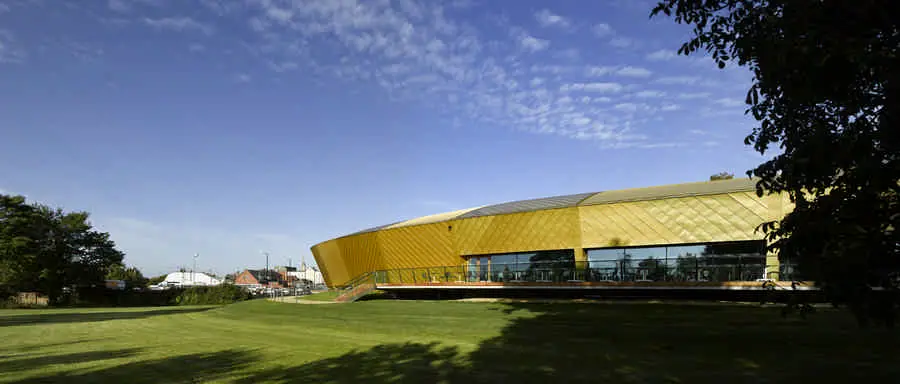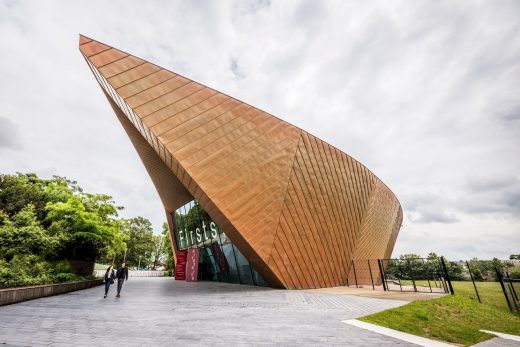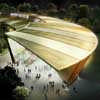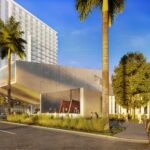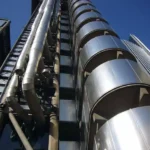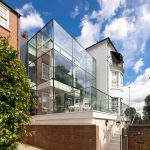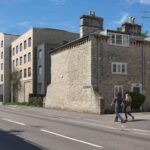firstsite centre for the visual arts, Colchester Building Architect, Rafael Viñoly England
firstsite Essex : Colchester centre for the visual arts
Building in Colchester, Essex, England, UK design by Rafael Viñoly Architects
post updated Mar 4, 2023
Rafael Viñoly, the world-renowned Uruguayan architect who designed this Essex building, and also the Walkie Talkie building in London, has died aged 78.
22 Sep 2021
New Centre for the Visual Arts
Design: Rafael Viñoly Architects
Firstsite Is Winner Of £100,000 Art Fund Museum Of The Year 2021
Firstsite Colchester, Essex: Museum of the Year
22 Sep 2011
New Centre for the Visual Arts Building
Design: Rafael Viñoly Architects
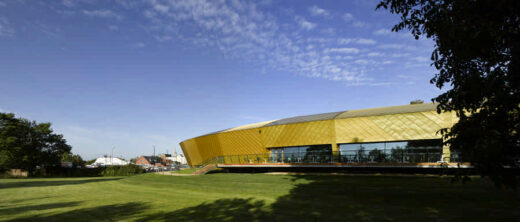
photo : Richard Bryant/ arcaidimages.com
firstsite Colchester
FIRSTSITE, NEW INTERNATIONAL CENTRE FOR THE VISUAL ARTS DESIGNED BY RAFAEL VIÑOLY OPENS
firstsite, a major new centre for the visual arts, designed by internationally acclaimed Rafael Viñoly Architects, will open in Colchester on Sunday 25 September 2011.
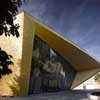
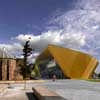
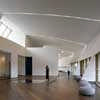
photos : Richard Bryant/ arcaidimages.com
Firstsite will be a home for the work of the long established visual arts organisation of the same name. Spread over 3,200 square metres on a landmark site bounded by the original Roman wall of Colchester, and set in extensive grounds, the new building will include purpose-built gallery spaces for major international exhibitions.
It will also feature a display space to showcase works from the University of Essex’s internationally important collection of Latin American art, extensive learning spaces for children, students and community groups, a destination bar/restaurant and a 190-seat auditorium suitable for film screenings, lectures and events. The building will be open every day and into the evening, free to all.
At its heart will be the newly restored Berryfield Roman Mosaic, which dates from around AD200. Unearthed in 1923 on the site where firstsite now stands, the Mosaic formed part of the floor of a Roman townhouse. After years in Colchester Castle, the Mosaic has been painstakingly restored and returned to its original home, as firstsite’s only permanent exhibit.
Since firstsite was founded in 1994, it has encouraged thousands of people to get involved in contemporary art, nurturing new talent and providing a network of opportunities for the community to participate in ambitious learning programmes. Alongside this, firstsite has exhibited such internationally acclaimed artists as Louise Bourgeois (1996), Antony Gormley (1999), Bridget Riley (2002), Yoko Ono (2003), and Mark Dion (2005). Louise Bourgeois’ seminal work ‘Spider’ was shown in Colchester in 1996, four years before Tate Modern first exhibited the larger version of the work in its Turbine Hall.
firstsite’s opening exhibition, Camulodunum (the Roman name for Colchester, after the Celtic war god Camulos), will celebrate the cultural and artistic heritage of the town and the region, which became established as the capital of Roman Britain. The exhibition will put on show important local historic artefacts alongside works by Barbara Hepworth, Henry Moore, Grayson Perry, JMW Turner, Andy Warhol and Ai Weiwei, and four commissions by international contemporary artists: Michaela Eichwald (Germany), Aleksandra Mir (Poland/Sweden/USA), Karin Ruggaber (Germany/UK) and Danh Vo (Denmark/Vietnam).
The new building is the product of a strategic partnership between Arts Council England, East of England Development Agency, Essex County Council, Colchester Borough Council, the University of Essex and firstsite. firstsite’s opening is part of a sustained cultural investment programme over the last decade in the East of England, which includes the opening of DanceEast in Ipswich, the expansion of performance facilities at Aldeburgh, the restoration of the Theatre Royal, Bury St Edmunds, and the upcoming development of Kettle’s Yard in Cambridge, providing a major regional focus for culture in England.
Katherine Wood, Director of firstsite, said: ‘I am proud to be opening our spectacular new building – designed by one of the world’s great architects, Rafael Viñoly, for the people of Colchester. So much more than a beautiful gallery attracting art lovers from all over the country, I believe firstsite will be at an important intersection between the community and artists, providing inspiration and encouragement to everyone to explore, create, relax and have fun.’
THE BUILDING
The building plan is a modified crescent that wraps around a D-shaped eighteenth-century garden. It slopes upwards in line with the site topography, culminating in a monumental portico which frames the lobby with full-height glazing. Contemporary in both form and cladding, built on a steel frame and wrapped in TECU Gold (a copper-aluminum alloy), the building engages with the site’s axial geometry and the preexisting period architecture.
All construction took place at elevations above the Scheduled Ancient Monument datum line because buried archaeological artefacts precluded excavation. The building therefore floats on a concrete raft foundation which required no deep excavation. One of those artefacts, the Berryfield Mosaic, is set into the floor beneath protective glass, providing a glimpse of the history buried under the building. Internal levels work with the contours of the site; twelve different floor slab levels create subtle slopes that draw people through the building.
An interior promenade carries visitors from the vast entrance space through to the auditorium, University and Mosaic spaces, learning areas and main exhibition spaces, ending up at the café restaurant, MUSA. The curved form of the building creates the sense of a journey that allows visitors to encounter artwork as they walk through the building.
The café restaurant at the end of this promenade provides social space lit by overhead clerestory windows; it includes an outdoor terrace which overlooks the adjacent gardens. Administrative space and galleries aligned on the inside arc of the building feature wide glazing that provides natural light and views of the adjacent eighteenth-century garden. Sensitive landscaping animates the open garden spaces, including artwork designed by artist Simon Periton installed September 2011.
In accordance with the design mandate to turn the traditional white cube gallery inside-out, extensive natural lighting and clear internal orientation is maintained by preserving sightlines to the outdoors. Floor-level strips of windows animate the design by revealing to visitors in the garden the movement of people inside, while also providing diffused light to the interior; clerestory windows give further natural light.
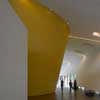
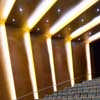
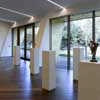
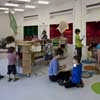
photos : Richard Bryant/ arcaidimages.com
THE SITE
The site, near the town centre of one of Britain’s first Roman settlements, sits on Scheduled Ancient Monument land, with an intact Roman wall defining the southern boundary. Because archaeological remains are scattered throughout the site, maximum loads on the ground and a no-dig policy, the building had to impose a minimum load on the existing topography.
As the first project in the revitalisation of Colchester’s historic St Botolph’s Quarter, firstsite anchors the long-term development plan of an underused district. Rafael Viñoly Architects PC proposed a number of revisions to the original St Botolph’s Quarter master plan, all of which were subsequently adopted.
The proposed building site was moved eastward, away from the town centre, redistributing the area of redevelopment. This facilitated a more sensitive relationship between the building and the historic assets of Colchester; specifically, by preserving the character of the north-south Queen Street/St Botolph’s Street corridor, which connects the Colchester Castle Museum (to the north) and the Colchester Town train station (to the south) with a gently curving street of historical buildings.
The new location situates the building in a park, creating new public space as an appropriate setting for a cultural destination. (A bus station was relocated to accommodate this new construction.) The site is now directly south of the eighteenth-century Grade I Listed East Hill House, which firstsite faces across a D-shaped garden that lends it its crescent shape, and whose Grade II gothic folly was separated from the house in the mid twentieth century by the construction of a bus station.
Views from the museum to the first-century Roman wall emphasise the historical importance of this ancient structure. Other prominent nearby structures include Grade II Listed twelfth century St James’s Church and the Minories Art Gallery, the latter a red-brick Georgian townhouse that served as firstsite’s original home, and which has been a gallery since the 1950s.
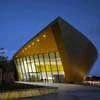

photos : Richard Bryant/ arcaidimages.com
SPACES
The auditorium is clad internally with diamond-patterned, suede-like acoustic fabric and overlapping European cherry timber shells. It will be used for film screenings, performances, lectures and presentations. Situated behind the Entrance space, it leads visitors on to the main gallery areas which are defined by a varied materials palette of an ammonia-fumed oak floor and angled/curving plasterboard walls. The Foundation for Sport and the Arts Gallery, a climate-controlled, museum-quality hanging space, is accompanied by many adaptable display opportunities.
The flexible spatial configuration promotes interaction between visitors and artists, as spaces can be opened up to the galleries to encompass learning, artist residencies, and exhibitions. Programmed spaces are clustered, with the learning spaces in one area, conference and administration facilities in another, the galleries are concentrated near the centre of the building, and the café restaurant MUSA at the far eastern end.
The newly restored Berryfield Roman Mosaic is located at the heart of the firstsite building. Dating from around AD200, the mosaic was unearthed in 1923 by a local tenant on the site where firstsite now stands. The Mosaic originally formed part of the dining room floor of a wealthy Roman townhouse. After 80 years in Colchester Castle, the Mosaic has been painstakingly restored and returned to its rightful home, as firstsite’s only permanent exhibit. Its design consists of a central rose motif surrounded by four panels depicting sea monsters chasing Dolphins.
The Mosaic, which has been carefully cleaned and now benefits from a new lightweight backing, is displayed horizontally in a case embedded into the floor of the building.
20 Jul 2011
firstsite Colchester Building
New Centre for the Visual Arts Building Design
INTERNATIONAL COMMISSIONS FOR OPENING EXHIBITION AT FIRSTSITE COLCHESTER
The Roman history of Colchester, the first city of Britain, is the starting point for Camulodunum, the opening exhibition at firstsite, the major new centre for the visual arts in Colchester designed by Rafael Viñoly. The exhibition will run from 25 September 2011 – 22 January 2012
Camulodunum, taking its title from the original Roman name of Colchester, will feature major commissions to British and international artists, as well as loans from collections including Tate, V&A, Arts Council England, the University of Essex Collection of Art from Latin America, Fitzwilliam Museum Cambridge, Art Institute Chicago and Kunsthaus Zürich.
The Berryfield Mosaic:
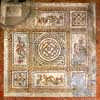
photo : Dougls Atfield
The exhibition will draw upon the town’s important collection of Romano-British artefacts including coins, ceramics and other aspects of Colchester’s archaeology, shown alongside artworks that consider the treatment of objects in the museum and contemporary culture as future historical record. Among these are works by Ai Weiwei, Subodh Gupta, Barbara Hepworth, Sarah Lucas, Henry Moore, Cildo Meireles, Grayson Perry, Robert Smithson, Bill Woodrow, and Andy Warhol.
The exhibition includes new commissions to four international artists: Michaela Eichwald, Aleksandra Mir, Karin Ruggaber and Danh Vo. Mir’s encyclopaedic HELLO Colchester will link one hundred found images to a photograph of a local soldier meeting Queen Elizabeth II, reflecting Colchester’s long history as a garrison town, from pre-Roman times to the present day. Danh Vo’s work features some of the first fragments completed as part of a two-year undertaking to fabricate a full scale replica of New York’s Statue of Liberty.
In partnership with the University of Essex Collection of Art from Latin America, works by two Latin American artists will be featured in the opening season at firstsite. A series of Zero Centavo and Zero Cent coins by the Brazilian conceptual artist Cildo Meireles will be shown, alongside original Iron Age and Roman coins. In a joint commission, a major new installation by the celebrated Venezuelan artist Carlo Cruz Diez, known internationally for his experiments in op and kinetic art, will be executed in town centre locations.
Firstsite will be a permanent home for the work of the long established visual arts organisation of the same name. Spread over 3,200 square metres on a landmark site bounded by the original Roman wall of Colchester, the new building will include purpose built gallery spaces for major international exhibitions, a display space to showcase works from the University of Essex’s internationally important collection of Latin American art, extensive learning spaces for children, students and community groups, and a 190 seat auditorium for film screenings, lectures and events. Admission to firstsite’s exhibition programme will be free to all.
The building is constructed around the newly restored Berryfield Roman Mosaic, which dates from approximately AD200. Unearthed in 1923 on the site where firstsite now stands, the Mosaic formed part of the floor of a Roman townhouse. After years in Colchester Castle, the Mosaic has been painstakingly restored and returned to its original home, as firstsite’s only permanent exhibit.
Camulodunum
firstsite, High Street, Colchester
Dates: 25 Sep 2011 – 22 Jan 2012
Opening hours: Mon – Sat 10am – 7pm ; Sun 10am – 5pm
Admission free
22 Jun 2011
firstsite Colchester Building News
New Centre for the Visual Arts Design
NEW INTERNATIONAL CENTRE FOR THE VISUAL ARTS DESIGNED BY RAFAEL VIÑOLY OPENS
Design: Rafael Viñoly Architects
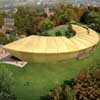
image from Rafael Viñoly Architects
firstsite is one of the partner organisations in the Plus Tate group, which also includes Nottingham Contemporary, Turner Contemporary in Margate, and The Hepworth Wakefield.
Cllr Paul Smith, Colchester Borough Council Portfolio Holder for Resources and ICT, said: ‘firstsite’s opening is a crucial milestone in the Borough’s plans to breathe life into the St Botolph’s quarter and establish opportunities to provide lifelong learning and skills development for all. Colchester’s new landmark building for the visual arts, firstsite will be a community hub for our town, county and region. It will draw visitors to Colchester, creating jobs in tourism and retail, and boost the economic growth of Colchester’s shops, hotels and restaurants.’
Helen Lax, Regional Director, Arts Council England, said: ‘It gives us great pleasure that firstsite will open its doors on 25 September. The new building is an important symbol of the vibrant arts scene in Colchester, and we hope it will act as a hub for the continuing development of local artists, as a draw for tourism and a catalyst for the town’s cultural regeneration.
firstsite has demonstrated ambition, passion and flair with its opening exhibition, Camulodunum. Renowned work by international artists such as Andy Warhol, JMW Turner and Henry Moore will be presented in an exhibition that at the same time reflects the importance of Colchester’s cultural heritage. This is a perfect mix – demonstrating the importance of firstsite’s aim to be locally relevant and internationally significant.’
County Councillor Peter Martin and leader of Essex County Council, said: ‘The arts in Essex make a tremendous contribution to our society and economy. I am very pleased to see that we are officially announcing the opening of yet another fantastic contribution to the Essex arts scene. firstsite will play an important role in Essex and we are delighted to be working closely with them in the exciting lead up to the opening of this iconic venue.’
Dr Tony Rich, Registrar of the University of Essex, said: ‘The opening of firstsite will bring vitality and modernity to historic Colchester, attracting national and international interest. The University has worked closely with firstsite on developing educational and cultural activities, and this world-class venue will help to engage and enthuse new audiences.’
About Colchester
Colchester, in Essex, is Britain’s oldest recorded town. It has been an important garrison town since Roman times, and today is the home of the British Army’s 16th Air Assault Brigade. Colchester attracts more than 4.5 million visitors every year, drawn by its wealth of historic treasures, including the Roman wall, Norman Castle, St Botolph’s priory, and award-winning museums; cultural institutions such as the renowned Mercury Theatre and Colchester Arts Centre; and the famous Colchester Zoo. Just a few miles outside the town, visitors can enjoy the landscape that inspired John Constable in the Dedham Vale Area of Outstanding Natural Beauty, and explore Mersea Island, home of the famous Colchester native oysters.
Rafael Viñoly
Born in Uruguay and raised in Argentina, Rafael Viñoly has been practicing architecture for over 45 years. As principal of Rafael Viñoly Architects PC (founded 1983 in New York), he has completed many critically and publicly praised buildings throughout the United States, Europe, Latin America, and Asia. He has also practiced in Africa and the Middle East.
Among Viñoly’s most significant projects are the Tokyo International Forum; the Kimmel Center for the Performing Arts in Philadelphia; and Curve – a performing arts centre in Leicester. He recently completed the Master Plan for the Abu Dhabi Campus for New York University in the United Arab Emirates, the Carrasco International Airport in Montevideo, Uruguay, and is currently working on the 20 Fenchurch Street Tower in London, and the Edward M Kennedy Institute for the Senate in Boston, Massachusetts, as well as a wide range of commercial, academic and civic schemes around the world.
Location: firstsite, Colchester, Essex, England, UK
Essex Building Designs
A House for Essex, England
Design: FAT Architecture + Grayson Perry
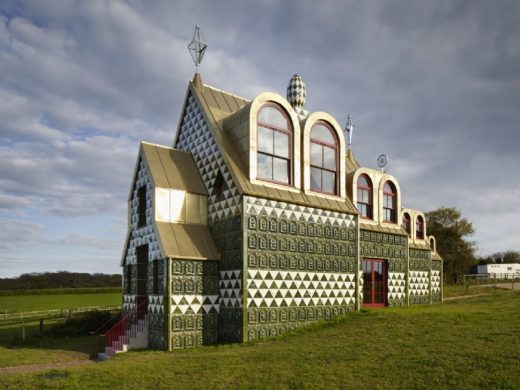
photo : Jack Hobhouse
A House for Essex
Newhall Be, Harlow, north west Essex
Design: Alison Brooks Architects
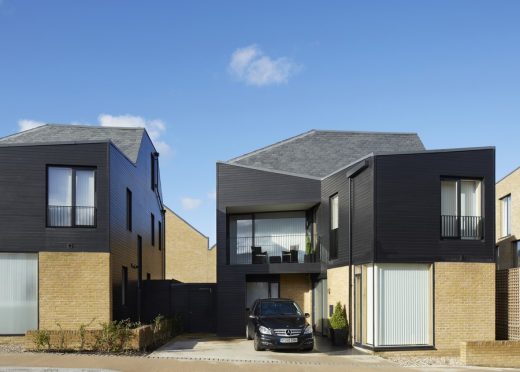
photo : Paul Riddle
Newhall Housing
Wildspace Rainham Warehouse
Design: Alison Brooks Architects
Wildspace Rainham Warehouse
Marshland Discovery Zone, Purfleet
Peter Beard_LANDROOM
Marshland Discovery Zone
Key contemporary Essex Buildings
Salt House (private), St Lawrence Bay
Alison Brooks Architects
Salt House
Salvation Army Citadel Corps building, Chelmsford
Hudson Architects
Salvation Army Essex
Housing at New Hall, Harlow
Richard Murphy Architects
Essex housing
Institute For Democracy and Conflict Resolution, University of Essex
Daniel Libeskind
University of Essex Institute For Democracy and Conflict Resolution
Stansted Airport, Stansted
Foster + Partners
Stansted Airport
Comments / photos for the firstsite centre for the visual arts, Colchester Building page welcome

